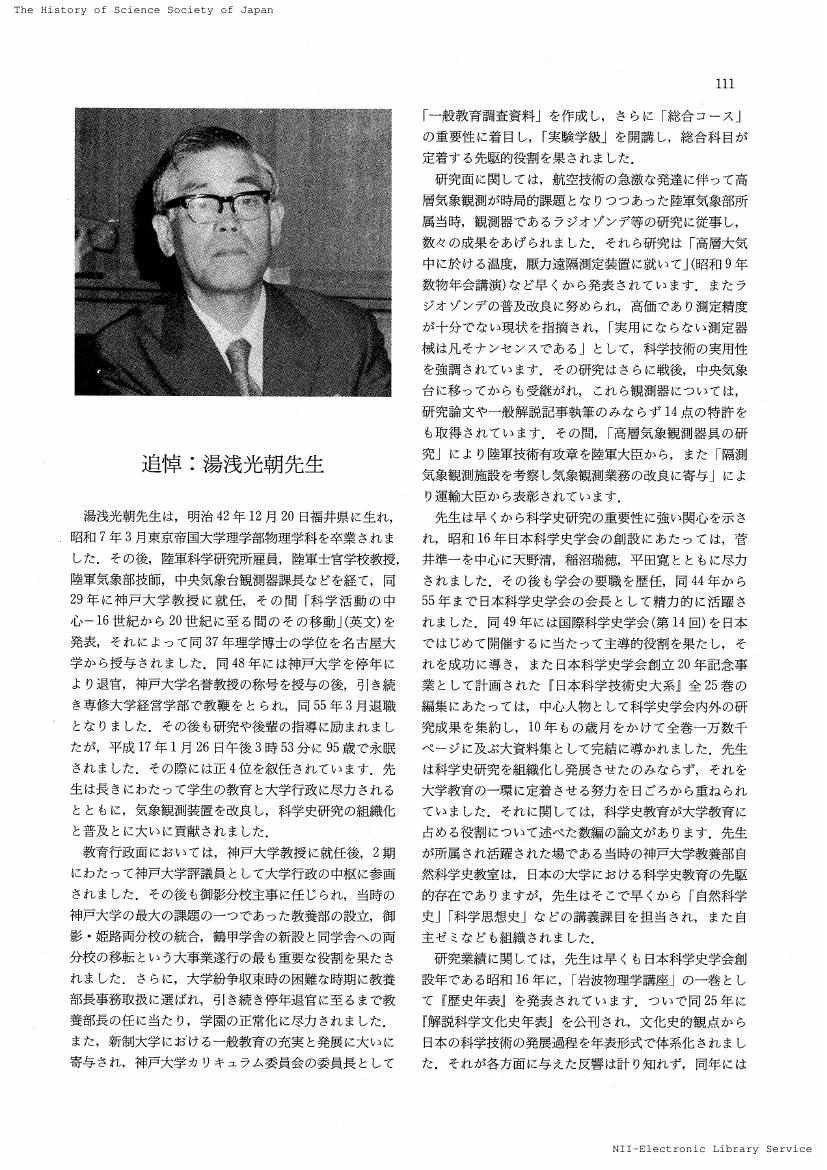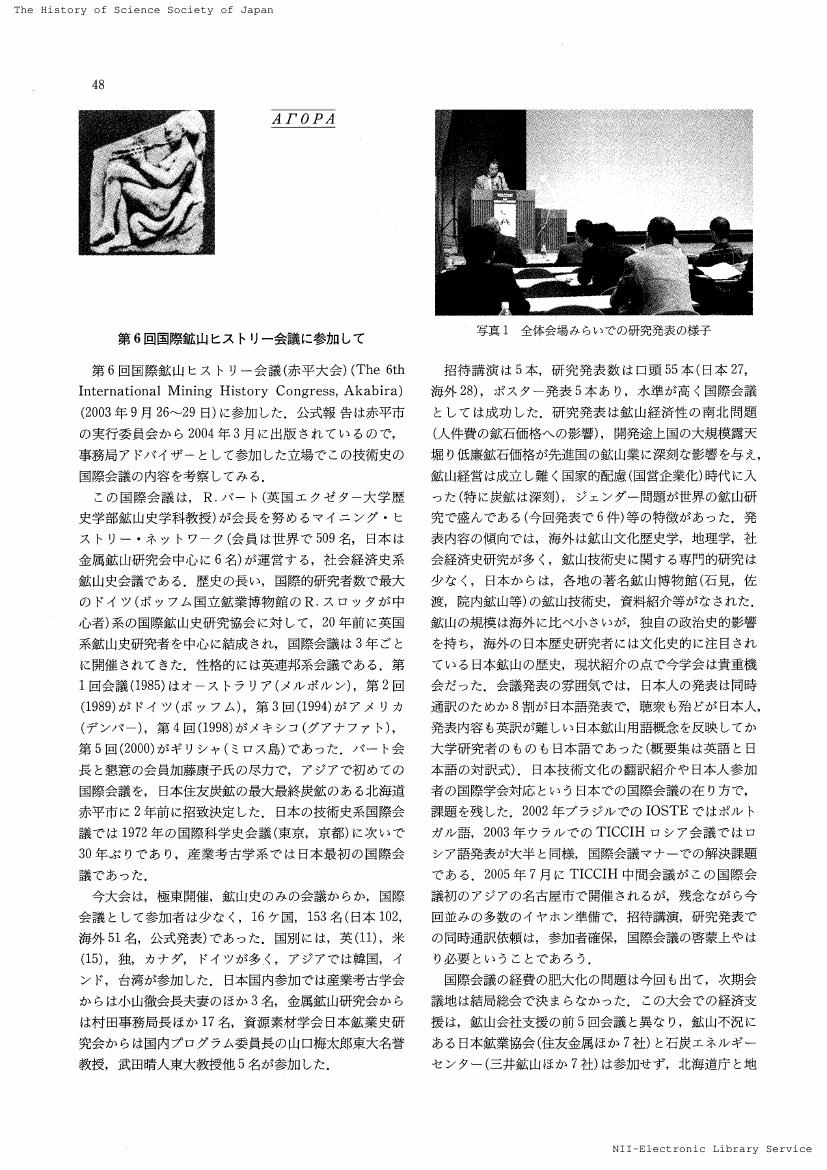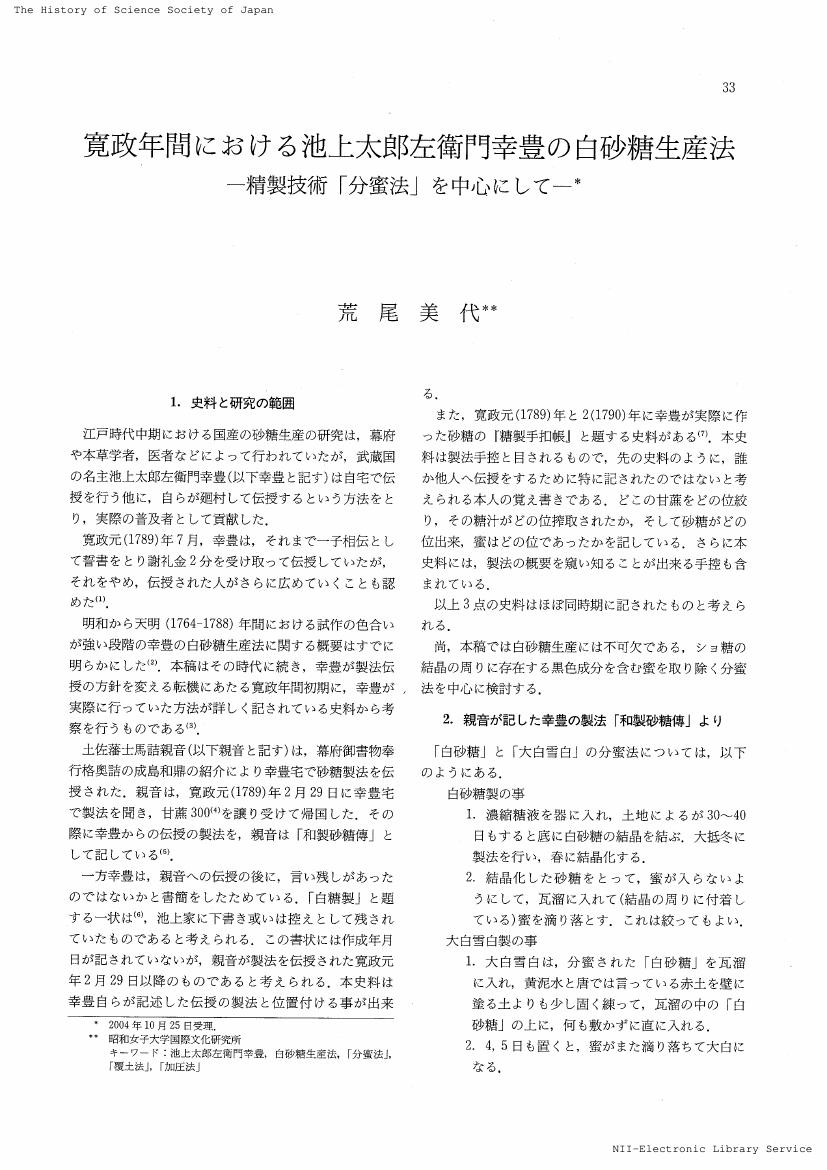1 0 0 0 OA 紹介
- 出版者
- 日本科学史学会
- 雑誌
- 科学史研究 (ISSN:21887535)
- 巻号頁・発行日
- vol.44, no.234, pp.114, 2005 (Released:2021-08-12)
1 0 0 0 OA 湯浅光朝先生
- 著者
- 三浦 伸夫
- 出版者
- 日本科学史学会
- 雑誌
- 科学史研究 (ISSN:21887535)
- 巻号頁・発行日
- vol.44, no.234, pp.111-113, 2005 (Released:2021-08-12)
1 0 0 0 OA 紹介
- 出版者
- 日本科学史学会
- 雑誌
- 科学史研究 (ISSN:21887535)
- 巻号頁・発行日
- vol.44, no.233, pp.50, 2005 (Released:2021-08-12)
1 0 0 0 OA 第6回国際鉱山ヒストリー会議に参加して(アゴラ)
- 著者
- 山田 大隆
- 出版者
- 日本科学史学会
- 雑誌
- 科学史研究 (ISSN:21887535)
- 巻号頁・発行日
- vol.44, no.233, pp.48-49, 2005 (Released:2021-08-12)
1 0 0 0 OA 「自然」(フュシス)と身体 : ポリュボス『人間本性論』における医学的「自然」観
- 著者
- 今井 正浩
- 出版者
- 日本科学史学会
- 雑誌
- 科学史研究 (ISSN:21887535)
- 巻号頁・発行日
- vol.44, no.233, pp.13-22, 2005 (Released:2021-08-12)
It has often been claimed that Greek medical science has its origin in the rational explanation of the world among the early Greek philosophers that constituted their inquiry into nature. However, there were doctors who made an attempt to establish medical science as existing independently of any philosophical intrusion. This can be elucidated through the analysis of the medical term physis, conceptualized, among others, in the well- known treatise in the Hippocratic Corpus, entitled De Natura Hominis (NH). In NH, the Hippocratic doctor criticizes philosophical anthropology and medical theory, which hold that human nature comes into being emergently from single elemental stuff such as Air, Water etc, or from a single humor. His own view of human nature claims that the four humors (blood, phlegm, yellow bile and black bile) constitute the nature (physis) of human body. The human body has its natural powers inherently for preserving health, and, if anything does harm to it, it functions autonomously for restoring its normal condition. In this context, the term physis denotes what determines the normality of the body, in which its humoral constituents remain harmonized with each other. Through the conception of physis, applied principally to the body, the human body will be demarcated as the physical or ,material aspect of human nature, as opposed to the monistic view of human nature, which has not drawn a categorical distinction between the material and non-material.
1 0 0 0 OA 国際地質学史委員会2004に参加して(アゴラ)
- 著者
- 矢島 道子 山田 俊弘
- 出版者
- 日本科学史学会
- 雑誌
- 科学史研究 (ISSN:21887535)
- 巻号頁・発行日
- vol.44, no.233, pp.46-47, 2005 (Released:2021-08-12)
1 0 0 0 OA シーボルトと日本の植物(科学史入門)
- 著者
- 石山 禎一
- 出版者
- 日本科学史学会
- 雑誌
- 科学史研究 (ISSN:21887535)
- 巻号頁・発行日
- vol.44, no.233, pp.39-42, 2005 (Released:2021-08-12)
1 0 0 0 OA 寛政年間における池上太郎左衛門幸豊の白砂糖生産法 : 精製技術「分蜜法」を中心にして
- 著者
- 荒尾 美代
- 出版者
- 日本科学史学会
- 雑誌
- 科学史研究 (ISSN:21887535)
- 巻号頁・発行日
- vol.44, no.233, pp.33-38, 2005 (Released:2021-08-12)
1 0 0 0 OA 復古王政期フランスの技術書出版ブーム
- 著者
- 中村 征樹
- 出版者
- 日本科学史学会
- 雑誌
- 科学史研究 (ISSN:21887535)
- 巻号頁・発行日
- vol.44, no.233, pp.1-12, 2005 (Released:2021-08-12)
In Restoration France 1814-1830, the advancement of industrialization had encouraged the mechanization of manufacturing processes, while weakening the apprenticeship as a legitimate training system for the artisans. In such circumstances, technical books began to emerge as a new channel to technical information. These technical books flourished especially in the latter half of the 1820s. This paper focuses on this "boom" of technical books in Restoration France. By conducting a quantitative analysis of Bibliographie de la France, the publication trend of the technical books will be examined, particularly with respect to format and price. From this analysis, it has be shown that the boojcs which triggered such a boom were the "manuals" -small in format, and moderately priced- of particular professions. These were elementary technical books available to the ordinary artisans. In order for these "manuals" to be actually useful, the contents mainly consisted of "practical knowledge," for each targeted profession. Moreover, in most of these manuals, the use of scientific terms were avoided, and instead, descriptions were given in everyday language. Indeed, some of them went as far as using the traditional measurement system, rather than the metric system. Although the actual number of copies of these "manuals" cannot be determined from existing data, presumably they had achieved certain commercial success. In fact, such manuals continued to be published constantly even after the 1830s, and a few of them became so popular that the revised editions had been published one after another.
1 0 0 0 OA 導電性高分子の誕生とその波及効果(第51回日本科学史学会年会報告)
- 著者
- 白川 英樹
- 出版者
- 日本科学史学会
- 雑誌
- 科学史研究 (ISSN:21887535)
- 巻号頁・発行日
- vol.43, no.232, pp.221-234, 2004 (Released:2021-08-12)
- 著者
- 水野 浩雄
- 出版者
- 日本科学史学会
- 雑誌
- 科学史研究 (ISSN:21887535)
- 巻号頁・発行日
- vol.43, no.232, pp.239-242, 2004 (Released:2021-08-12)
1 0 0 0 OA 中国周辺の少数民族の抄紙法から見た「澆紙法」の発達過程の考察
- 著者
- 小林 良生
- 出版者
- 日本科学史学会
- 雑誌
- 科学史研究 (ISSN:21887535)
- 巻号頁・発行日
- vol.43, no.232, pp.193-203, 2004 (Released:2021-08-12)
On the presumption that minorities in Southern China and her peripheral countries still conserve ancient papermaking techniques, field and literature surveys were made for extraction of elemental techniques of hand papermaking and arranging them in the developing order from viewpoints of paper science. These techniques are classified into two methods, molding and squeezing of pulp (or plant fibers) suspension. In this report developing steps of molding method were observed and discussed. The author propose that the most primitive technique is to disperse a viscous solution dispersed with plant fibers on horizontally supported dry canvas as observed in Yao tribes. The next step is floating mold in which water pools are provided in several ways. Finally floating mold using a shallow vat with legs made it possible to make paper by a standing figure. Further the sallow vat is improved to provide bamboo bars at the edge for putting frames containing wet sheets.
1 0 0 0 OA アラビア文明圏の科学史と理科教育
- 著者
- 伊東 俊太郎
- 出版者
- 日本科学史学会
- 雑誌
- 科学史研究 (ISSN:21887535)
- 巻号頁・発行日
- vol.43, no.232, pp.235-238, 2004 (Released:2021-08-12)
1 0 0 0 OA 紹介
- 出版者
- 日本科学史学会
- 雑誌
- 科学史研究 (ISSN:21887535)
- 巻号頁・発行日
- vol.43, no.232, pp.247, 2004 (Released:2021-08-12)
1 0 0 0 OA 19世紀末における藤沢利喜太郎の算術教育論(科学史入門)
- 著者
- 矢島 敬二
- 出版者
- 日本科学史学会
- 雑誌
- 科学史研究 (ISSN:21887535)
- 巻号頁・発行日
- vol.43, no.232, pp.243-246, 2004 (Released:2021-08-12)
1 0 0 0 OA 千葉県立中央博物館蔵『円理弧背術』について
- 著者
- 横塚 啓之
- 出版者
- 日本科学史学会
- 雑誌
- 科学史研究 (ISSN:21887535)
- 巻号頁・発行日
- vol.43, no.232, pp.204-210, 2004 (Released:2021-08-12)
TAKEBE Katahiro (1664-1739) was a famous mathematician in the Edo period in Japan and was an outstanding pupil of SEKI Takakazu (?-1708) who was an authority on Japanese traditional mathematics. The Enri Kohai-jutsu has been thought to be a book by TAKEBE. One of the manuscripts is preserved in the Hayashi collection of Tohoku University's library (call number : Hayashi 911) and there is another manuscript in the Boso sugaku collection of Natural History Museum and Institute, Chiba (call number : Boso sugaku-collection No. 178). Differences can be found between them. They are especially different in the second half.
1 0 0 0 OA 国家のための科学 : 1920〜30年代日本の地震探査
- 著者
- 金 凡性
- 出版者
- 日本科学史学会
- 雑誌
- 科学史研究 (ISSN:21887535)
- 巻号頁・発行日
- vol.43, no.232, pp.211-220, 2004 (Released:2021-08-12)
In this paper, I describe the process through which Japanese seismology tried to contribute to the development of a new technology, seismic exploration, in the interwar period. Even though the former authority enjoyed by Japanese seismology had been in decline since the early 1920s, the skill of the scientists who had devised seismographs and analyzed seismograms could be applied to the new technology. Seismic exploration, i. e., prospecting for oil using artificial seismic waves, was welcomed as a new way of contributing to Japan's quest for petroleum. On the other hand, some civil engineers who worked for the National Railway adapted this new promising technology for their own purpose, which further disseminated the application of the earthquake science. Because of the cooperation of scientists and engineers, seismic exploration in Japan developed, by the mid 1930s, to the extent that it was recognized as a military science. However, the conflict as to the purpose, leadership, and identity of seismic exploration had been born in the process, which disturbed the unification of the practitioners.
1 0 0 0 OA 第51回 日本科学史学会 年会・総会 報告
- 出版者
- 日本科学史学会
- 雑誌
- 科学史研究 (ISSN:21887535)
- 巻号頁・発行日
- vol.43, no.231, pp.180-185, 2004 (Released:2021-08-12)
1 0 0 0 OA 20世紀初頭物理学における二つの研究伝統
- 著者
- 安孫子 誠也
- 出版者
- 日本科学史学会
- 雑誌
- 科学史研究 (ISSN:21887535)
- 巻号頁・発行日
- vol.43, no.231, pp.129-137, 2004 (Released:2021-08-12)














